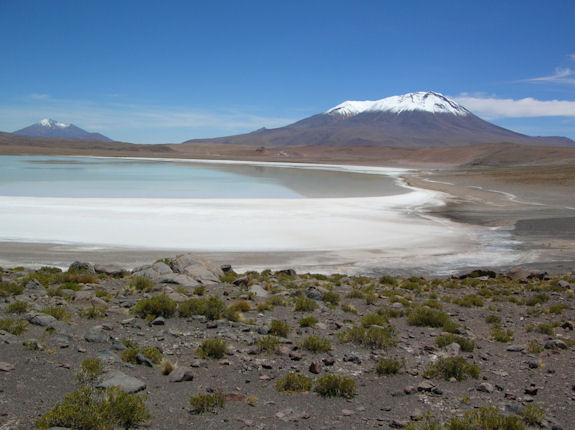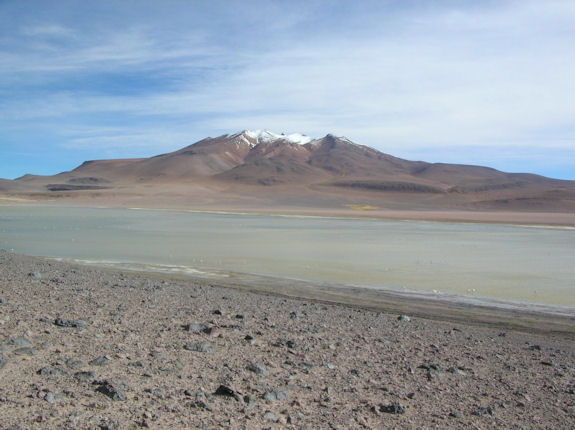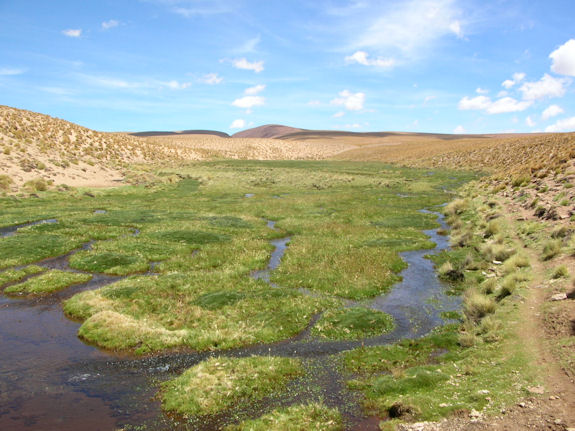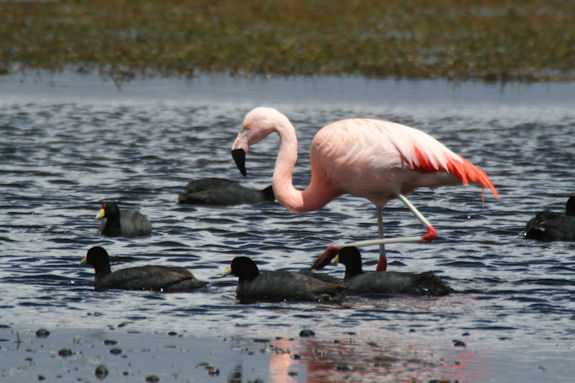High-altitude Bolivian site vastly enlarged
 During the 6th workshop on the Regional Strategy for the Conservation and Sustainable Use of High-Andean Wetlands (21-24 September, La Paz, Bolivia), the Ramsar Advisor for the Americas presented to Mr Juan Pablo Ramos, Vice-Minister of Environment, Biodiversity, and Climate Change in Bolivia the site certificate for the extension of the Laguna Colorada Ramsar site, designated in 1990, from 51,000 hectares to nearly 1.5 million hectares. As summarized by Ramsar’s Nadia Castro, the expanded site, now renamed “Los Lípez” in Potosí department (1,427,717 ha, 22°10’S 067°24’W) is located in the Bolivian Altiplano between 4,200 and 6,000m altitude and now includes a complex of high Andean endorheic permanent saline, hypersaline and brackish lakes, as well as “bofedales” and geothermal wetlands. These wetlands sustain such migratory birds as Phalaropus tricolor and Calidris bairdii, who use the wetlands as staging sites for roosting and feeding. The Horned Coot (Fulica corneta) and Darwin’s Rhea (Rhea pennata garleppi), a very threatened subspecies, are also present. In addition, ca. 25% and 50% of the global population of the Andean flamingo (Phoenicoparrus andinus) and James’s Flamingo (Phoenicoparrus jamesi), respectively, concentrate in this area. There are also threatened non-avian species such as the endemic frog Telmatobius huayra, the Andean Mountain Cat Leopardus jacobita, and the colocolo Leopardus colocoloi.
During the 6th workshop on the Regional Strategy for the Conservation and Sustainable Use of High-Andean Wetlands (21-24 September, La Paz, Bolivia), the Ramsar Advisor for the Americas presented to Mr Juan Pablo Ramos, Vice-Minister of Environment, Biodiversity, and Climate Change in Bolivia the site certificate for the extension of the Laguna Colorada Ramsar site, designated in 1990, from 51,000 hectares to nearly 1.5 million hectares. As summarized by Ramsar’s Nadia Castro, the expanded site, now renamed “Los Lípez” in Potosí department (1,427,717 ha, 22°10’S 067°24’W) is located in the Bolivian Altiplano between 4,200 and 6,000m altitude and now includes a complex of high Andean endorheic permanent saline, hypersaline and brackish lakes, as well as “bofedales” and geothermal wetlands. These wetlands sustain such migratory birds as Phalaropus tricolor and Calidris bairdii, who use the wetlands as staging sites for roosting and feeding. The Horned Coot (Fulica corneta) and Darwin’s Rhea (Rhea pennata garleppi), a very threatened subspecies, are also present. In addition, ca. 25% and 50% of the global population of the Andean flamingo (Phoenicoparrus andinus) and James’s Flamingo (Phoenicoparrus jamesi), respectively, concentrate in this area. There are also threatened non-avian species such as the endemic frog Telmatobius huayra, the Andean Mountain Cat Leopardus jacobita, and the colocolo Leopardus colocoloi.
Due to its landscape beauty and natural attractions the site is the most visited protected area in Bolivia (ca. 70.000 tourist/year), which has caused negative impacts on the lakes. Mining represents another important threat. The Ramsar site covers two of the 14 priority sites of the Wetland Network of Importance for Conservation of High-Andes Flamingos in Argentina, Bolivia, Chile and Peru. Half of the Ramsar site is protected under the National Andean Wildlife Reserve Eduardo Avaroa. As Laguna Colorada, the original site was added to the Montreux Record, 16 June 1993, and removed from the Record, 7 August 1996.
Eduardo Avaroa. As Laguna Colorada, the original site was added to the Montreux Record, 16 June 1993, and removed from the Record, 7 August 1996.
 Preparations for the Ramsar site designation were assisted by WWF International’s Freshwater Programme, the Danone Fund for Ramsar, and the Fundación Yuchán.
Preparations for the Ramsar site designation were assisted by WWF International’s Freshwater Programme, the Danone Fund for Ramsar, and the Fundación Yuchán.
Bolivia presently has 8 Ramsar sites covering an area of 7,894,472 hectares.
Photos by Omar Rocha

Laguna Hedionda

Laguna Pelada

Bofedal Rio Quetena

Flamenco chileno y fulicas

Flamenco de james